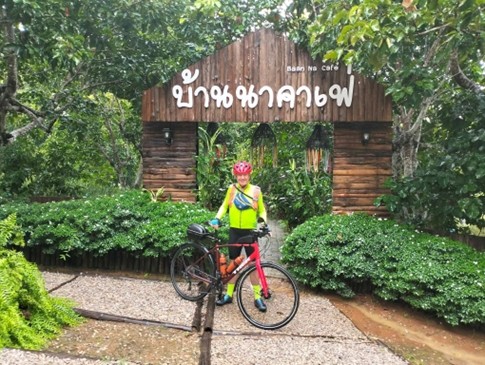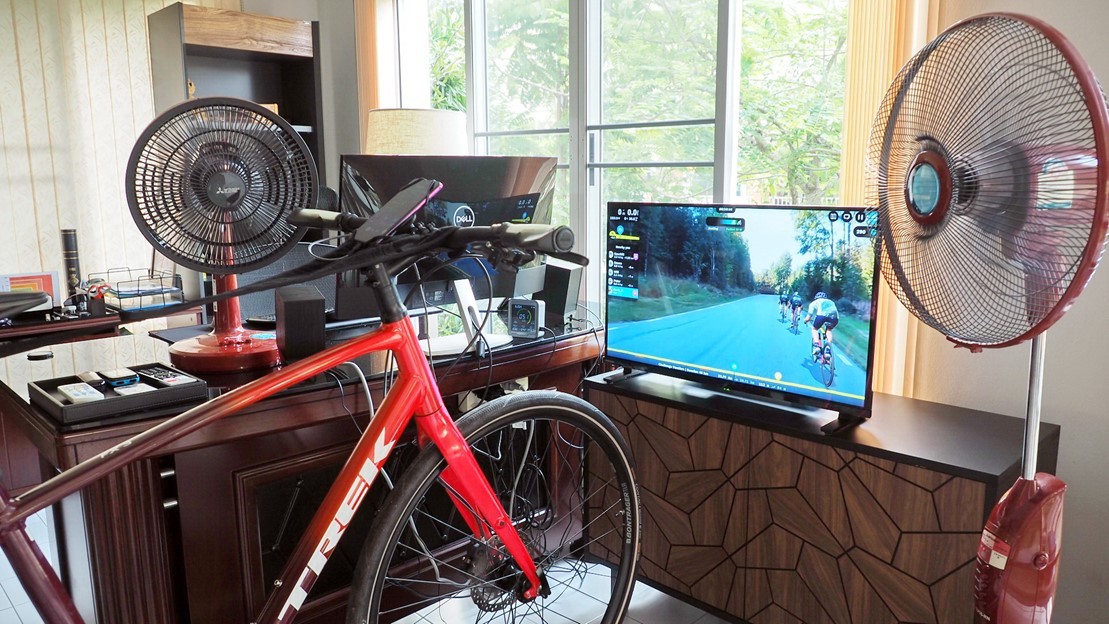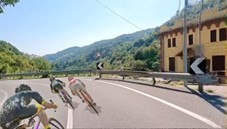The first time that I circumnavigated the world it took 207 days, when I had the privilege to be the Staff Marine Engineer Officer and Group Public Relations Officer of the Royal Navy’s flagship of Naval Task Group 2000, HMS Cornwall. Today, 24 years later, after cycling 25164 km in 924 hours over 452 days I completed my second circumnavigation of the world. This time virtually.
The route included: Shanghai, Tokyo, Vancouver, Houston, Milan, Muscat and Bombay while ascending the equivalent of Mount Everest, eight times. One of my favourite rides of 100 km was to Khun Korn waterfall at Chiang Rai, Thailand, via the White Temple. 
Having turned 64 a week ago, I share this lifetime achievement to highlight that it is possible to recover the peak fitness of your 20s if you set a medium term challenge, inquisitively research nutrition and understand the significant risk of atrial fibrillation, which affects many who try to regain their youth too quickly and increases the risk of a stroke tenfold.
The diet that I have developed is, I think, unique and comprises 50% of energy from fats, 30% from carbohydrates and 20% from proteins. It encompasses the panoply of necessary vitamins and minerals with particular attention to electrolytes and Omega 3 fats and an overarching emphasis of fresh, wholesome, natural foods. Protein is essential to help counter sarcopenia, which affects everyone over 30 years of age.
Conventional wisdom is that protein should be taken after exercise. That may be true for 30 minutes of resistance training, after which protein repairs torn muscle fibres, but I consume proteins before, during and after aerobic exercise to avoid muscular atrophy during my rides that tend to three hours or more. To ensure my diet is comprehensive and efficacious I have biannual tests for: lipids (cholesterol and triglycerides); complete blood count; minerals and electrolytes; and, perhaps the most important, vitamin D. 
Haemoglobin is critical for transporting oxygen to the muscles but needs heme iron from meat, fish and poultry. Vitamin D is essential for many metabolic processes, including building bone density with vitamin K2, magnesium and calcium but it is also critical for brain growth and preventing dementia, sometimes described as Type 3 diabetes. Sunlight is the primary source so as a supplement, vitamin D3 is the most easily absorbed form.
Despite widespread mainstream misinformation, based on outdated propaganda from 60 years ago with the distorted Seven Countries Study, I consume a relatively high level of fats and eat an egg everyday, and yet my cholesterol score is exceptionally good with a risk considerably less than half the average. The Seven Countries Study effectively resulted in the Standard American Diet, which recommends carbohydrates, (sugar and starch) as the main component. The sugar industry in the USA receives billions of dollars in subsidies every year, paid by US taxpayers. No wonder that more than 80 percent of Americans have insulin resistance; the precursor to diabetes. 
The online QRisk® tool, developed by British doctors, calculates my heart age to be 57 with a 6% risk of a cardiovascular event in the next 10 years, compared to other healthy, white men of the same age. For peace of mind, two years ago I had an electro and an echo cardiogram. The cardiologist stated that my heart was perfectly normal.
Nonetheless, conscious of the risk of atrial fibrillation I was careful never to push my heart rate too high, relying on Karvonen’s formula to calculate heart rate training zones and always using a chest strap heart rate transmitter and monitor when exercising to keep mainly within the aerobic zone, but with controlled and short bursts of high intensity training when riding up hills which generates the human growth hormone. A fitness watch is not as reliable nor as accurate and is difficult to monitor while exercising, but wearing one is still a useful backup and provides detailed training analysis.
The general guidance is that your maximum heart rate is 220 minus your age. You then calculate training zones based on that maximum rate. Karvonen’s formula importantly improves on this by taking into account your personal fitness, by which I mean resting heart rate. If healthy, the lower your resting heart rate the greater your fitness and heart rate reserve, which means you can exercise harder.
When I stated that it is possible to recover the fitness of your young adulthood my resting heart rate is 46 beats per minute, in the top 1% of the population. In my early 20s, when I ran every day and won the Top of the Rock Race at Gibraltar, it was 35 bpm. A few years later, at the Royal Navy Engineering College, when I trained for half triathlons and rowed for the college, it was about 50 bpm. So that previous assertion was not hyperbole.
Martti Karvonen was a Finnish cardiologist who was awarded his PhD at Cambridge in 1950. After studying the lifestyles and earlier ages of deaths of Finnish soldiers in the Eastern Army compared with those in the Western Army, he devised his fairly simple but highly effective formula in 1957. Click for further information about Karvonen’s formula.

For the past 3 months or so during the monsoon season, when there is a significant risk of a lightning strike or accident, I predominantly used the brilliant Rouvy app with a smart trainer to ride over 7,000km, through 20 countries, from my home. This facilitated an increase of a rolling seven day average to 90 km/day @ 30 kph and 35 kph on the flats; I started the challenge at just 18 km/day @ 18 kph. Of note, 90 km at 30 kph burns about the same energy as running a half marathon in a good time.
Strava is another online app, used by over 100 million subscribers worldwide, but principally for planning routes and logging cycling, running and swimming sessions. The enduring feature for me has been the monthly challenges, especially distance and elevation. For the past four months I have been in the top 1,000 of over a quarter of a million other riders worldwide. My focus is being in the top 10 of over 300 Strava cyclists in Thailand. For three of the past four months I was in the top three, and the first among subscribers. So, when I am tempted to ease off the throttle I think of maintaining that top position, which is excellent motivation to keep going, every day.
As I neared the end of my Ride the World in 500 Days challenge, I began to push harder by competing in short (~20 km) Rouvy racing events during which my heart rate was at, near, or even higher than the maximum theoretical rate, but it took 25,000 km, 400 days and great care to get to that critical stage.
Please note that I assess my maximum heart rate with the QRisk® calculated heart age rather than calendar age, as I think that is more realistic, and ultimately safer for anyone with cardiovascular issues when the heart age will be higher than one’s life age. In the research that I have undertaken for a book about aerobic maintenance, this may be a world-first in thinking and, in my view, is a helpful refinement of Karvonen’s well established method. 
Even if you have a heart condition it does not mean that you cannot exercise. Indeed, the opposite is true. A fitting quote from a British Colombia Medical Journal article, “The Science of Exercise Prescription: Martti Karvonen and His Contributions”, dated February 2017: “The work of a founding father of cardiovascular disease epidemiology in Finland suggests that physicians might consider writing a prescription for exercise before they write a prescription for an antihypertensive or antihyperglycemic agent.”
To conclude, if you are considering starting any endurance activity while in your 50s or 60s, please be careful, be patient and take your time. I strongly recommend getting a medical check-up but especially check your heart with a cardiologist who will advise of any constraints if you have a problem. And always use a chest strap heart rate transmitter with an appropriate monitor, such as a bike computer, during training and Karvonen’s formula.
Mark Smith CEng
email with any questions at RtW_500@iCloud.com